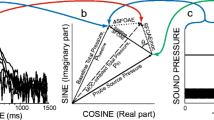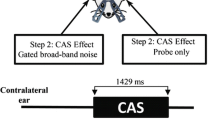Abstract
The physiology of the medial efferent olivocochlear system involves suppressive interactions of contralateral sounds on ipsilateral sound-evoked responses, but its role is largely unknown to date. Medial efferents act at the level of cochlear outer hair cells via cholinergic synapses and might affect their mechanical activity, thereby modulating auditory sensitivity. The aim of the present work was to obtain noninvasive measurements of distortion-product otoacoustic emissions (DPOEs), which reflect outer hair cell function, in order to establish the characteristics of medial efferent-induced suppression in awake, restrained guinea pigs. A clear suppression of DPOEs was induced by continuous contralateral white noise presented at 20–70 dB SPL, in the absence of any confounding effect of anesthesia, middleear muscles, or acoustic cross talk. Recently, acute injection of a high dose of the aminoglycoside antibiotic gentamicin (150 mg/kg) was reported to alter the suppressive effect of contralateral noise on eighth nerve-compound action potentials, presumably by blocking efferent synapses to outer hair cells. This hypothesis was confirmed with DPOEs for which a single injection of gentamicin at the same dose abolished suppression after about 1–2 h, whereas no change in basal levels was observed. Complete recovery was obtained after 48 h. This experiment may provide an easy, noninvasive tool for studying auditory function with and without functioning efferents.
Similar content being viewed by others
References
Allen JB (1990) User manual for the Cubdisp distortion product measurement system. AT&T Bell Laboratories
Aran JM, Erre JP, Avan P (1995) Contralateral suppression of transient evoked otoacoustic emissions in guinea pigs: effects of gentamicin. Br J Audiol 28: 267
Avan P, Loth D, Menguy C, Teyssou M (1991) Hypothetical roles of middle ear muscles in the guinea pig. Hear Res 59: 59–69
Bourret C, Mallart A (1989) Depression of calcium current at mouse motor nerve endings by polycationic antibiotics. Brain Res 478: 403–406
Brown AM (1987) Acoustic distortion from rodent ears: a comparison of responses from rats, guinea pigs and gerbils. Hear Res 31:25–38
Brown AM, McDowell B, Forge A (1989) Acoustic distortion products can be used to monitor the effects of chronic gentamicin treatment. Hear Res 42: 143–156
Brown MC, Nuttall AL (1984) Efferent control of cochlear inner hair cell responses in the guinea pig. J Physiol (Lond) 354: 625–646
Brownell WE, Bader CR, Bertrand D, Ribaupierre Y de (1985) Evoked mechanical responses of isolated cochlear outer hair cells. Science 227: 194–196
Buño WJr (1978) Auditory nerve fiber activity influenced by contralateral ear sound stimulation. Exp Neurol 59: 64–74
Collet L, Kemp DT, Veuillet E, Duclaux R, Moulin A, Morgon A (1990) Effect of contralateral auditory stimuli on active cochlear micromechanical properties in human subjects. Hear Res 43: 251–262
Davis H (1983) An active process in cochlear mechanics. Hear Res 9: 79–90
Dulon D, Zajic G, Aran JM, Schacht J (1989) Aminoglycoside antibiotics impair calcium entry but not viability and motility in isolated cochlear outer hair cells. J Neurosci Res 24: 338–346
Eróstegui C, Sugasawa M, Dulon D (1995) Aminoglycoside antibiotics reversibly block acetylcholine-induced currents in guinea pig outer hair cells. In: Popelka G (ed) Abstracts of 18th ARO Midwinter Meeting 323: 81
Evans EF, Nelson PG (1973) The responses of single neurons in the cochlear nucleus of the cat as a function of their location and the anaesthetic state. Exp Brain Res 17: 402–427
Eybalin M (1993) Neurotransmitters and neuromodulators of the mammalian cochlea. Physiol Rev 73: 309–373
Fex J (1959) Augmentation of cochlear microphonic by stimulation of efferent fibers to the cochlea. Acta Otolaryngol 50: 540–541
Fiekers JF (1983) Effects of the aminoglycoside antibiotics, streptomycin and neomycin, on neuromuscular transmission. I. Presynaptic considerations. J Pharmacol Exp Ther 255: 487–495
Galambos R (1956) Suppression of auditory nerve activity by stimulation of efferent fibers to cochlea. J Neurophysiol 19: 424–437
Guinan JJ (1986) Effect of efferent neural activity on cochlear mechanics. Scand Audiol [Suppl] 25: 53–62
Hotz MA, Harris FP, Probst R (1994) Otoacoustic emissions: an approach for monitoring aminoglycoside-induced ototoxicity. Laryngoscope 104: 1130–1134
Housley GD, Ashmore JF (1991) Direct measurement of the action of acetylcholine on isolated outer hair cells of the guinea pig cochlea. Proc R Soc Lond (Biol) 224: 161–167
Kawase T, Liberman MC (1993) Antimasking effects of the olivocochlear reflex. I. Enhancement of compound action potentials to masked tones. J Neurophysiol 70: 2519–2532
Kemp DT (1979) Evidence of mechanical nonlinearity and frequency selective wave amplification in the cochlea. Arch Otorhinolaryngol 224: 37–45
Kim DO, Molnar CE, Matthews JW (1980) Cochlear mechanics: nonlinear behavior in two-tone responses as reflected in cochlear-nerve-fiber responses and in ear-canal sound pressure. J Acoust Soc Am 67: 1704–1721
Kirk DL, Johnstone BM (1993) Modulation of f2-f1: evidence for a GABA-ergic efferent system in the apical cochlea of the guinea pig. Hear Res 67: 20–34
Kroese AB, Das A, Hudspeth AJ (1989) Blockage of the transduction channels of hair cells in the bullfrog's sacculus by aminoglycoside antibiotics. Hear Res 37: 203–217
Kujawa SG, Glattke TJ, Fallon M, Bobbin RP (1993) Contralateral sound suppresses distortion product otoacoustic emissions through cholinergic mechanisms. Hear Res 68: 97–106
Kujawa SG, Glattke TJ, Fallon M, Bobbin RP (1994) A nicotiniclike receptor mediates suppression of distortion product otoacoustic emissions by contralateral sound. Hear Res 74: 122–134
Liberman MC (1989) Rapid assessment of sound-evoked olivocochlear feedback: suppression of compound action potentials by contralateral sound. Hear Res 38: 47–56
Mangham CA (1984) The effects of drugs and systemic disease on the acoustic reflex. In: Silman S (ed) The acoustic reflex. Academic, Orlando, pp 1–34
Mills DM, Norton SJ, Rubel EW (1994) Development of active and passive mechanics in the mammalian cochlea. Audiol Neurosci 1: 77–100
Møller AR (1984) Neurophysiological basis of the acoustic middle-ear reflex. In: Silman S (ed) The acoustic reflex. Academic, Orlando, pp 1–34
Patuzzi RB, Thompson ML (1991) Cochlear efferent neurones and protection against acoustic trauma: protection of outer hair cell receptor current and interanimal variability. Hear Res 54: 45–58
Pittinger CB, Adamson R (1972) Antibiotic blockade of neuromuscular function. Annu Rev Pharmacol 12: 169–184
Probst R, Lonsbury-Martin BL, Martin, GK (1991) A review of otoacoustic emissions. J Acoust Soc Am 89: 2027–2067
Puel JL, Rebillard G (1990) Effect of contralateral sound stimulation on the distortion product 2f1–f2: evidence that the medial efferent system is involved. J Acoust Soc Am 76: 1713–1720
Robles L, Ruggero MA, Rich NC (1991) Two-tone distortion in the basilar membrane of the cochlea. Nature 349: 413–414
Ruggero MA, Rich NC (1991) Furosemide alters organ of Corti mechanics: evidence for feedback of outer hair cells upon the basilar membrane. J Neuroscience 11: 1057–1067
Scharf B, Magnan J, Collet L, Ulmer E, Chays A (1994) On the role of the olivocochlear bundle in hearing: a case study. Hear Res 75: 11–26
Schmiedt RA (1986) Acoustic distortion in the ear canal. I. Cubic difference tones: effects of acute noise injury. J Acoust Soc Am 79: 1481–1490
Sellick PM, Patuzzi R, Johnstone BM (1982) Measurement of basilar membrane motion in the guinea pig using the Mössbauer technique. J Acoust Soc Am 72: 131–141
Smith DW, Erre JP, Aran JM (1994) Rapid, reversible elimination of medial olivocochlear efferent function following single injection of gentamicin in the guinea pig. Brain Res 652(2): 243–248
Subramaniam M, Salvi RJ, Spongr VP, Henderson D, Powers NL (1994) Changes in distortion-product otoacoustic emissions and outer hair cells following interupted noise exposures. Hear Res 74: 204–216
Takeuchi S, Wangemann P (1993) Aminoglycoside antibiotics inhibit maxi-K+ channel in isolated cochlear efferent nerve terminals. Hear Res 67: 13–19
Tran Ba Huy P, Manuel C, Meulemans A, Sterkers O, Amiel C (1981) Pharmacokinetics of gentamicin in perilymph and endolymph of rat as determined by radioimmunoassay. J Infect Dis 143: 476–486
Whitehead ML, Martin GK, Lonsbury-Martin BL (1992) Effects of the crossed acoustic reflex on distortion-product otoacoustic emissions in awake rabbits. Hear Res 51: 55–72
Wiederhold ML (1986) Physiology of the olivocochlear system. In: Altschuler RA, Bobbin RP, Hoffman DW (eds) Neurobiology of hearing: the cochlea. Raven, New York, pp 349–370
Author information
Authors and Affiliations
Rights and permissions
About this article
Cite this article
Avan, P., Erre, JP., da Costa, D.L. et al. The efferent-mediated suppression of otoacoustic emissions in awake guinea pigs and its reversible blockage by gentamicin. Exp Brain Res 109, 9–16 (1996). https://doi.org/10.1007/BF00228621
Received:
Accepted:
Issue Date:
DOI: https://doi.org/10.1007/BF00228621




